Binge Watching Glaciers
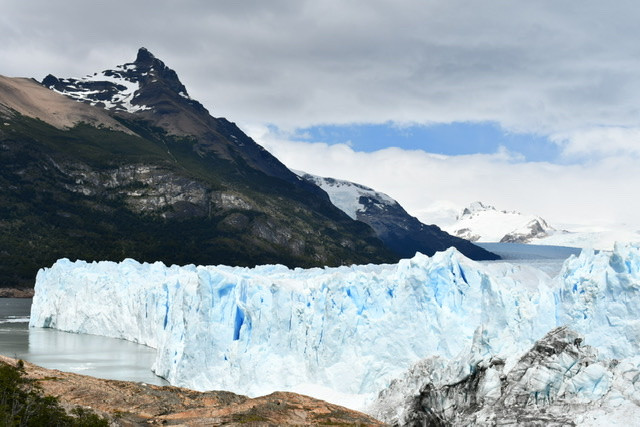
Much like binge watching Breaking Bad, binge watching glaciers is long periods of semi-captivating story building, auto-conjecture and suspense followed by interjections of OMG!! action.
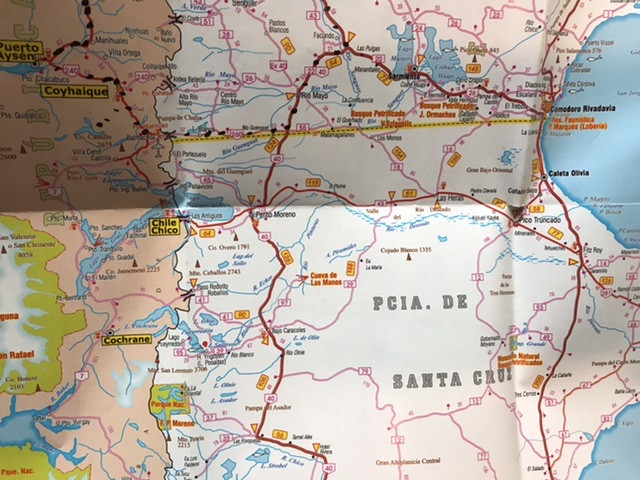
We knew we wanted to see a glacier for Christmas. That was one of those stubborn, sticks-in-the-head things we’d already decided. We also knew It was a long way to go from Gobernador Costa, The town we camped out after watching the rodeo, to reach El Calafate, the nearest town to Parque Nacional Los Glacieres. We looked at the map to see what was ahead. There were long stretches of straight highway.
We did see Lago Strobel as a possible fishing stop. That’s the fabled “Jurassic Lake” hyped & promoted heavily by a U.S. fly fishing travel company. I thought that would be an interesting place to see until an email came in the week previous from an acquaintance who was having a difficult time fishing there in roaring winds. (Roaring winds were in effect as we were driving by Strobel on Ruta 40.) Winds may or may not have been a factor causing the violent rollover of a small truck we saw alongside R40 in that immediate area; we didn’t bother to inquire with the police and ambulance cleaning up the scene. (Note: in 8500 km of travel in Argentina and Chile, this was the first and only accident we’ve witnessed in two countries with notorious free-for-all driving tactics.)
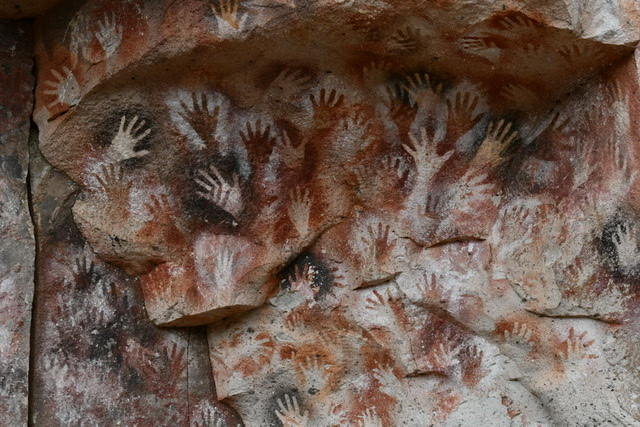
We did see El Cuevo de Las Manos see related article). It was placed in a perfect position to break up our travel.
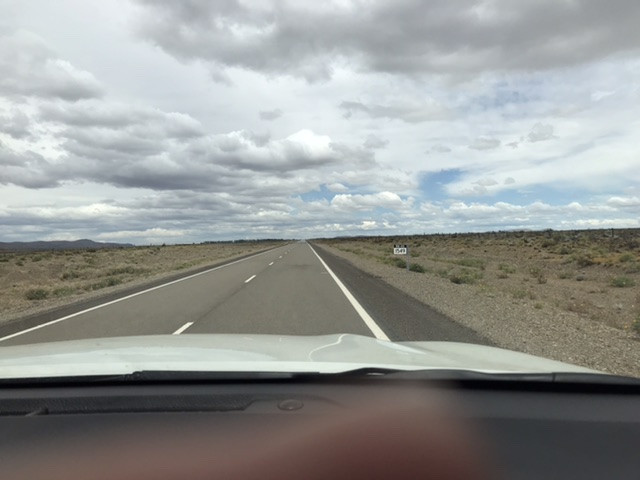
The remainder of the route was just good-ol, Ruta 40. Long, long stretches of flat, featureless desert land and high winds.
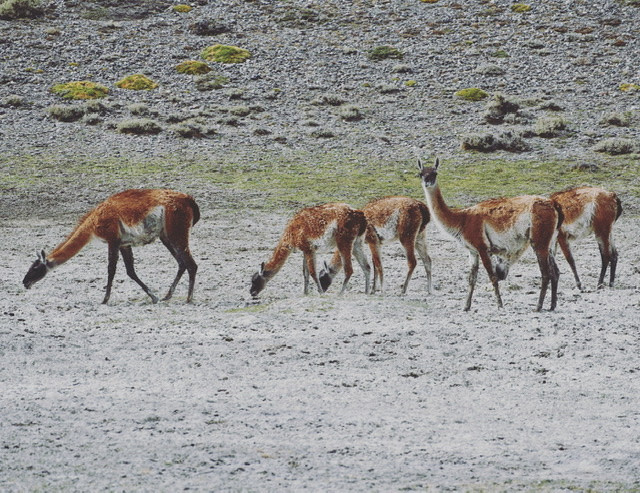
The one thing that kept our immediate attention was the numerous herds of guanacos standing along the highway shoulder. The highway shoulders, made of spec gravel, seem to hold moisture better than the surrounding earth of the countryside and thus had greener feed for the animals. The considerable amount of dead guanacos in the ditch was a testament to the risk of that survival strategy. From far away we would see a herd lining both sides of the highway as we approached. Guanacos are highly unpredictable and thus we quickly learned to honk our horn beginning from a half-kilometer away so that they could decisively organize their retreat in one direction.
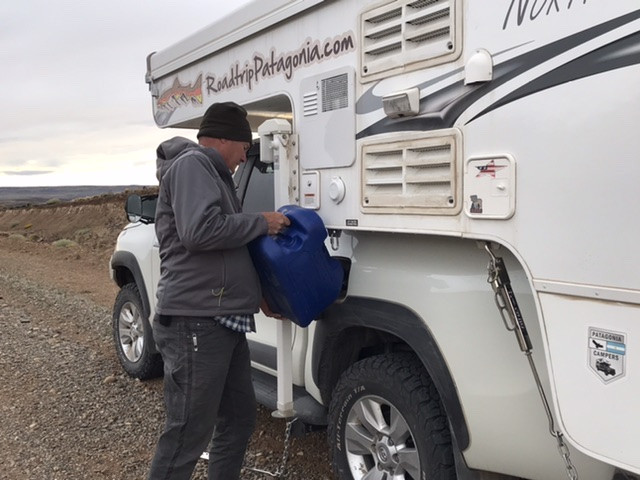
Earlier in the trip we almost ran out of fuel on one long, lonely stretch of Ruta 40 between Mendoza and Neuquén Provinces. After that we immediately purchased two 20 L fuel cans to carry spare fuel in the back of the camper in the event we faced such a scenario again. We put the fuel cans within plastic storage tubs to act as secondary containment in case altitude or vibration caused the seals of the fuel cans to fail. We’ve been schlepping the heavy tubs in-and-out of the camper at every stop, using them as side tables when camped. We were glad we had them. In the section of road between Perito Moreno and El Calafate there was one, crappy fuel stop to be had at the town we camped Christmas Eve called Tres Lagos. We would not have made Tres Lagos without the extra fuel due to fierce quartering headwinds absolutely crushing our fuel economy.

We spent the night at Tres Lago’s tucked in some trees at what turned out to be a very nice campground. As the wind roared overhead we toasted Christmas Eve with a French couple, traveling by car, and three German men traveling by motorcycle. Nobody was at the campground office when we arrived nor when we left We tucked 200 pesos into an envelope, with a thank you note, and slid it under the door.
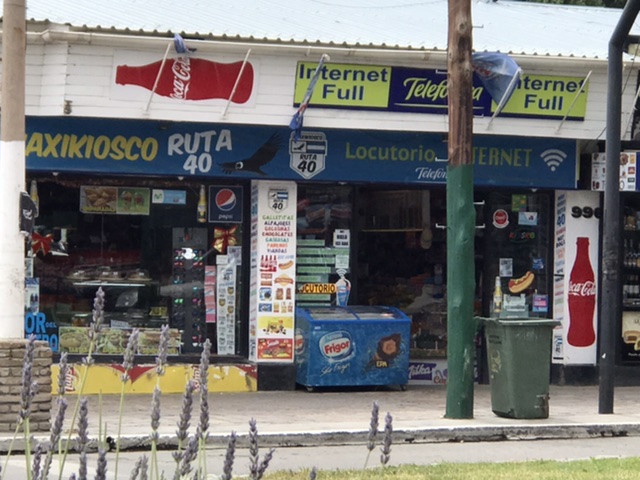
Rolling into El Calafate, we were confronted with the reality of it being Christmas day. Every grocery store in town was closed, some posted closings until New Year’s Day. Thank goodness the fuel stations were open. We grabbed some empanadas at a local kiosco, the countries version of the mini market. The proprietors of these kioscos, being the only game in town for getting anything resembling food, were making bank selling to Christmas travelers. Although it was three in the afternoon, we decided we’d head to the glacier and spend the night there.
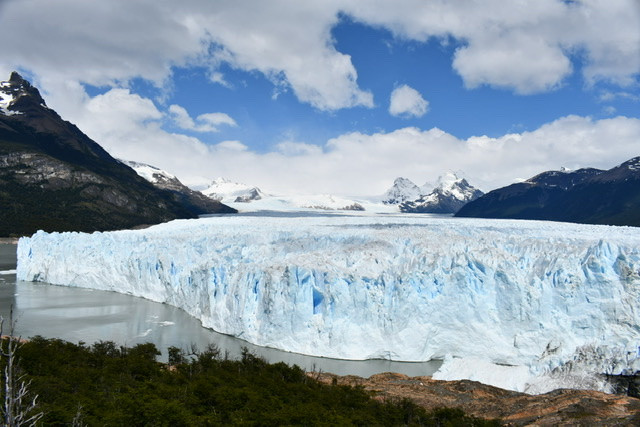
Being Alaskans, we’ve seen a lot of glaciers. We’ve seen glaciers from great distances. We’ve seen small glaciers, we’ve seen large glaciers. We’ve flown over them, we have landed on them in ski planes. We’ve seen them from boats. We have never seen them face-to-face, with time to savor the experience, like we did the Perito Moreno glacier.
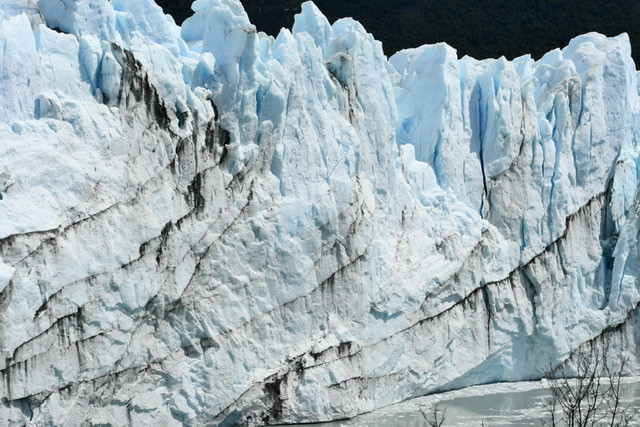
The Perito Moreno glacier, at 298 square miles, is the largest in South America. It’s part of the Southern Patagonian Ice Field encompassing an area of 4,826 square miles and shared by Argentina and Chile. The Ice Field contains 48 major glaciers and more than 100 minor glaciers.
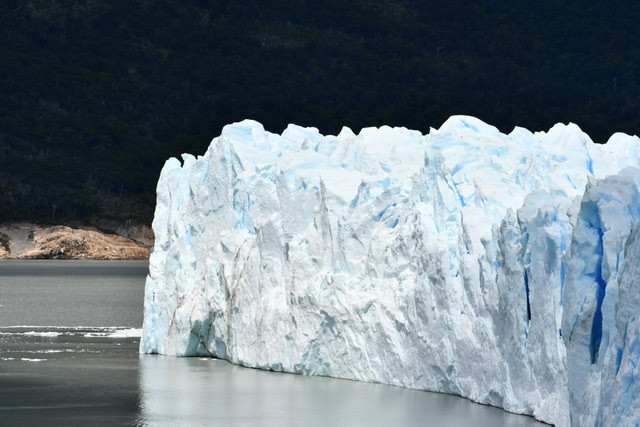
The Perito Moreno is a glacier on the move. As you crest out of the parking lot and begin walking down to it all 225 feet of its height greet you as it descends from the Andes and dumps into Lago Argentino. it’s a stunning effect.
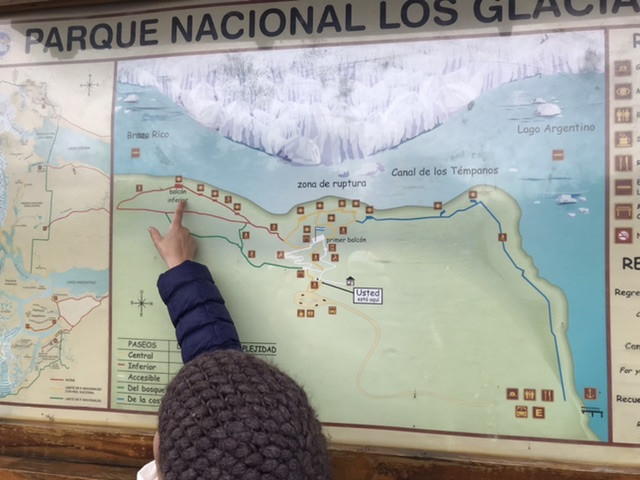
The Argentine National Park system has created an ingenious walkway, stairway and viewing platform system to take in multiple aspects of the glacier. We spent most of the first afternoon dealing with wind, rain, overcast and Christmas crowds as we ran the various stairways searching for an ideal vantage point.
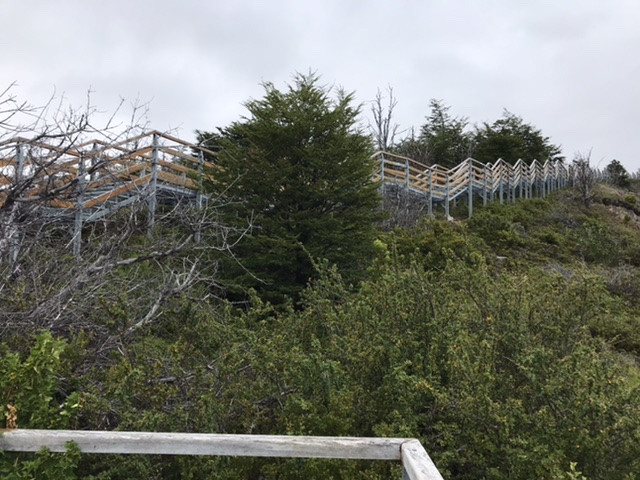
We found one, And spent two hours getting into the groove of listening, watching, and waiting for the glacier to calve chunks of ice into the lake. But, alas, soon enough the Park was closing and we had to leave. We were exhausted from the day of driving and running around. After briefly considering poaching a hidden place within the park to camp overnight (offered to us on our GPS), which was prohibited, we decided to do the right thing & leave the Park to find an outside campground.
We were told by the park ranger upon entering if we went to a particular campground, about 50 km outside of the park, we could get our tickets stamped and get in free the next day. Reviews on our GPS database said the campground was pretty good but expensive. We decided, having with no other option in sight, we would go there.

5 km along another winding, potholed, washboard and dusty road, We came to an establishment offering camping. It was called Estancia Rio Mitres. We were both sick of driving. The place had a 50-mile view of Lago Argentino.
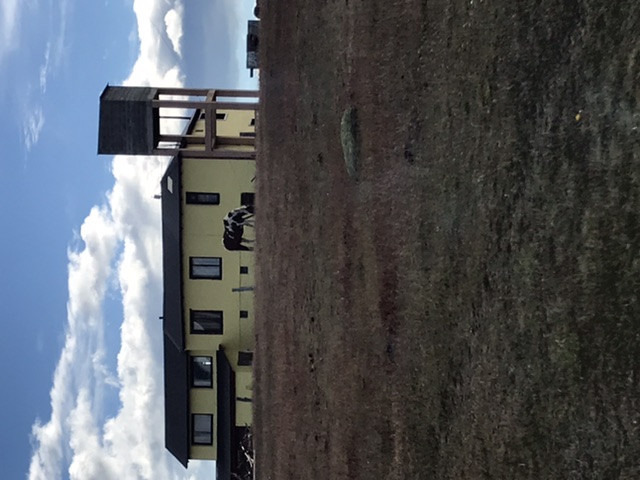
The Estancia looked small & inviting so we pulled in.
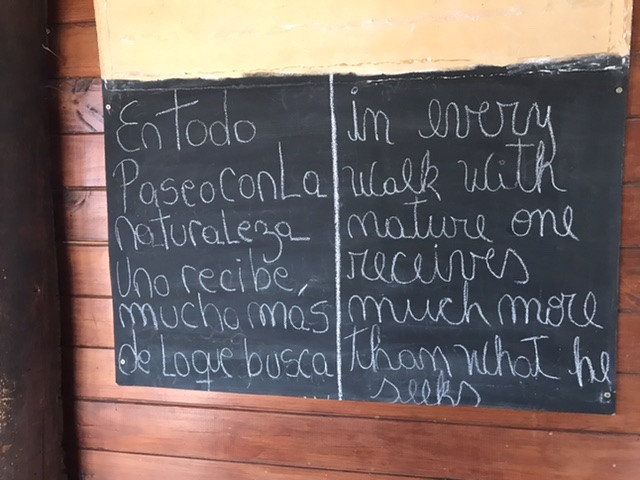
We were immediately greeted by Kiki, who owned the little Estancia with her husband. Kiki is one of those rare, radiant souls that instantly put you at calm and ease. Although she spoke very little English, we took her welcome. Kiki, like Lynnette does at Crystal Creek Lodge, even posts an inspirational message of the day. We decided this was the place to be.
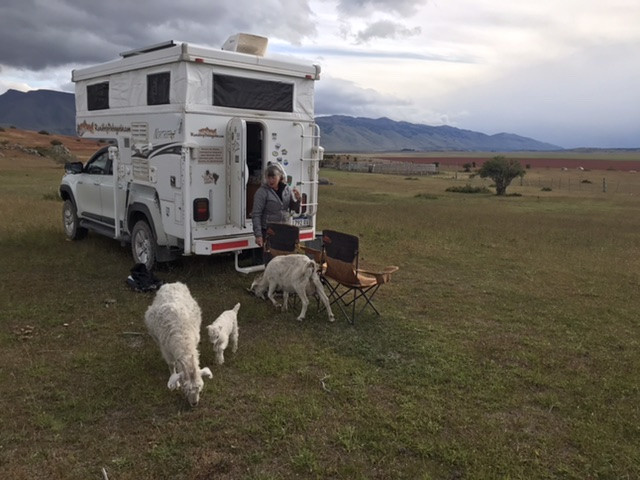
We set up the camper in a field below the estancia quincho, or grilling house, and were immediately surrounded by friendly goats and dogs. Chickens strolled the field and horses were paddocked nearby.
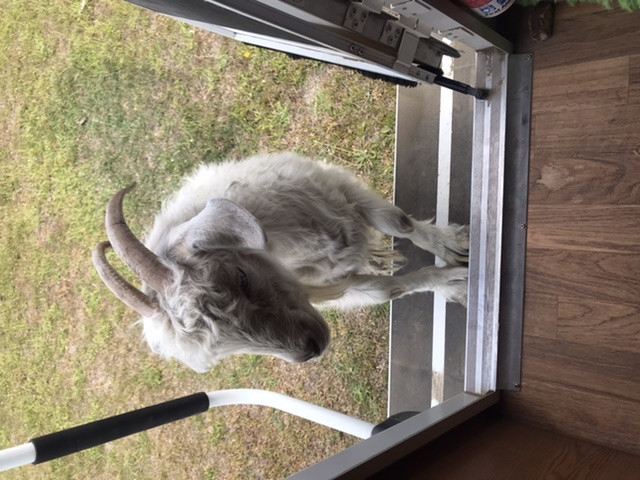
The goats even tried to get into our camper by leaping the steps and jumping inside. After pulling one out by the horns, we had a glass of wine & a laugh, then closed the camper and went to dinner.
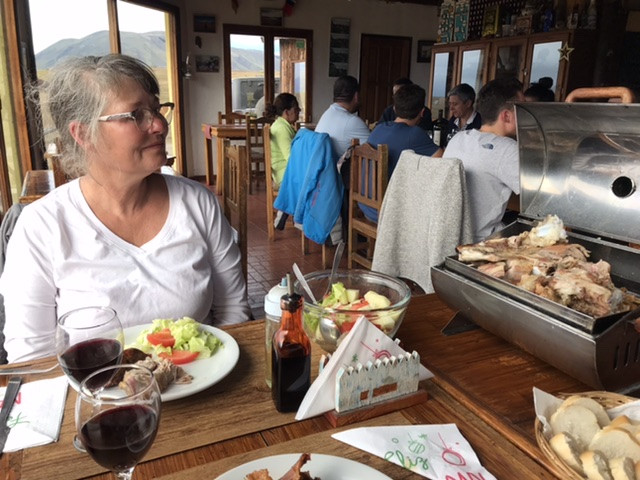
The quincho looked more like a frontier museum of campo artifacts and very poorly stuffed animals, posed in comical positions when the taxidermy was done in antiquity. There was a gigantic open hearth and a friendly gaucho, named Simon, grilling meat. It was perfect for us. After our welcome and receiving a bottle of wine, we were served an empanada. They were filled with goat meat. Upon finishing our empanada we were presented a huge, shiny brazier and told: “Provecho!” We rolled back the brazier lid to find it filled with goat meat. That would explain why there were two female goats swollen with milk around our camper and only one kid. It was all very delicious.
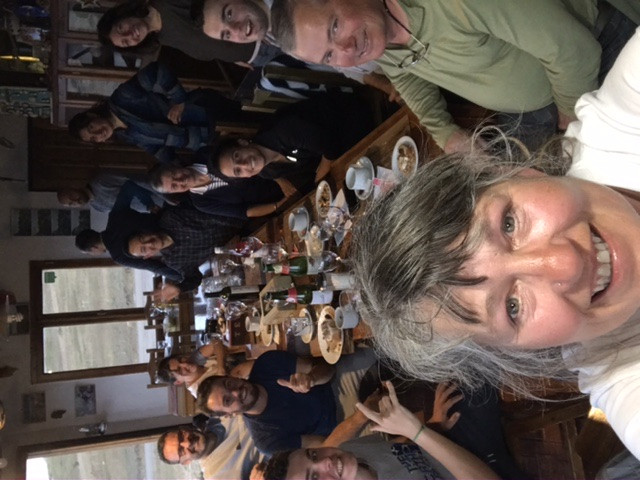
Upon finishing our meal a gentleman approached our table and spoke in French-accented English that he would like us to join their family for dessert. and a champagne toast for Christmas. We noticed they were only eating empanadas and we asked them why. We did not want to eat goat meat three meals in a row, he replied, because they had eaten goat for dinner, then lunch, and the women had lost their appetite after watching the kid be slaughtered and skinned.
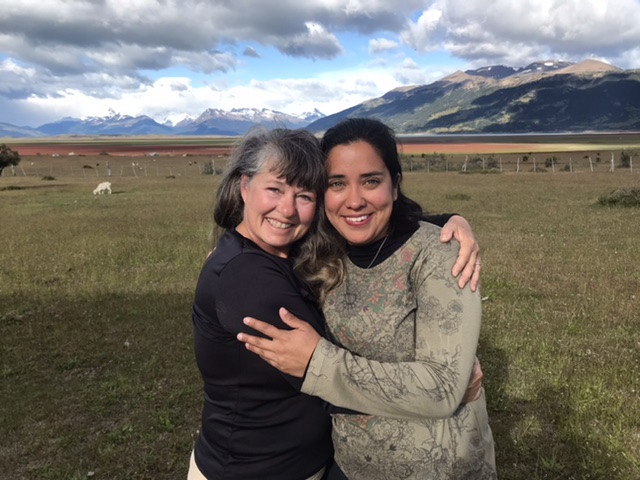
The next morning we arose to be in the Park early to beat the crowds and see the glacier again. It was a beautiful day. Kiki asked: “Will you be returning tonight?” I asked: “What’s for dinner?” Kiki replied: “Goat.” We said we’d be moving on.
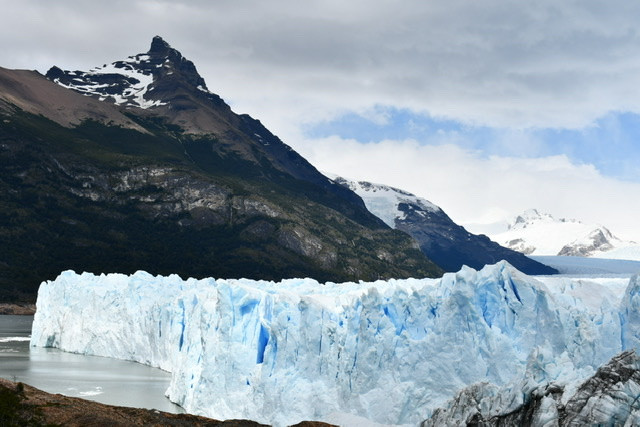
Upon returning back to the glacier we arrived under partly cloudy skies to see an entirely different view than we had the night before. The sun seemed to offer a veritable kaleidoscope of light contrasts from the ice of various ages and compactions.
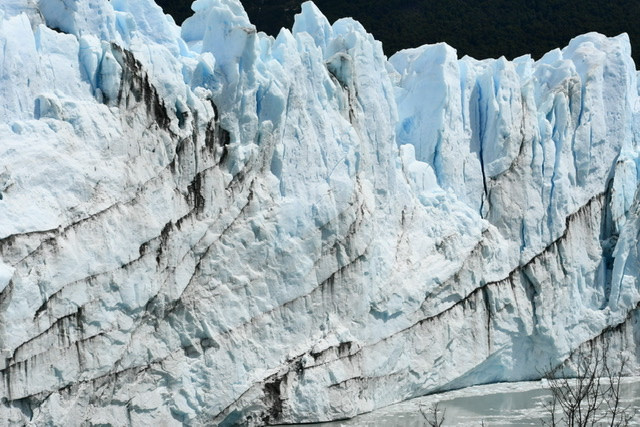
Traces of earth could be seen in the walls of the glacier where it had ground against the hills scores of kilometers inland. At the very bottom, the ice was deep blue as it was highly compressed.
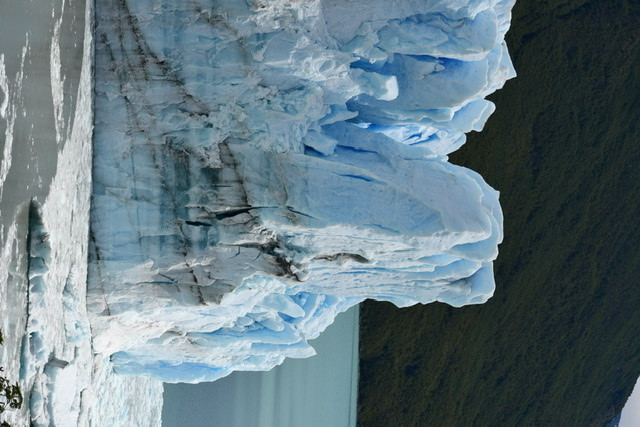
We don’t know if it was because of the sun on that day, but the glacier was moving, highly audible and calving ice constantly. It sounded like a combination of gunshots, thunder then lightning claps as the ice shifted, broke, fell then hit the water with echoing slaps. We took a lot of photos and, hoping to get a glimpse of an ice calve, sat with our phones at the ready to video.
Catching a video was truly hopeless unless it happened by a total accident of having our cameras on and pointed the right direction. We then put our cameras away and were content to sit and watch, waiting for rumbles and flickers of movement. As we picked our places and sat quietly, people speaking a myriad of languages known and unknown walked past, behind us. One particularly lucky chap was right next to us face-timing and speaking an unknown dialect of Spanish to whom we could only assume was a distant relative when the largest calving of the day broke right before his camera. We could hear the person on the other end squealing with delight.
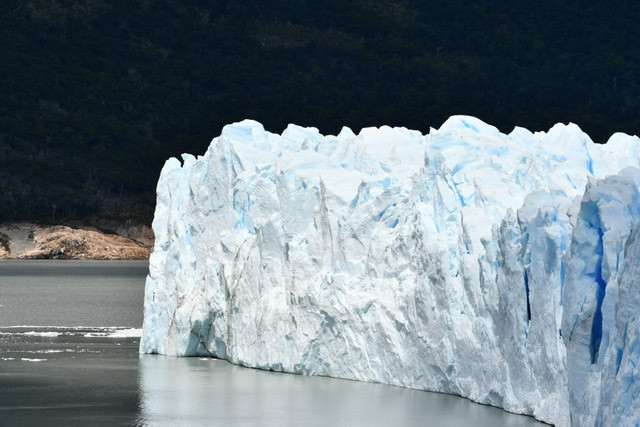
It became to the point that we did not want to move or take our eyes off the glacier we were so addicted to the possibility of a giant chunk of ice breaking free and we’d miss it. As we strolled the walkways we were literally taut as gunfighters, whirling to face the slightest sound from the glacier.

By the end of the day the rain, wind and overcast had returned. We begrudgingly told ourselves it was time to move-on and get a campsite in town, where we would restock with groceries, do laundry and take it easy for a couple days. We laughed with another couple from the US who had come to the same conclusion we did about not wanting to turn away from the glacier for an instant.
As we turned away from the glacier and set foot on the first flight of steps we heard: “boom!” behind us.
